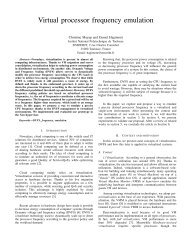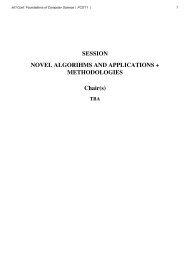SESSION GRAPH BASED AND TREE METHODS + RELATED ...
SESSION GRAPH BASED AND TREE METHODS + RELATED ...
SESSION GRAPH BASED AND TREE METHODS + RELATED ...
- TAGS
- graph
- methods
- world-comp.org
Create successful ePaper yourself
Turn your PDF publications into a flip-book with our unique Google optimized e-Paper software.
24 Int'l Conf. Foundations of Computer Science | FCS'12 |<br />
Improved Minimum Spanning Tree Heuristics for<br />
Steiner Tree problem in graph<br />
Ali Nourollah 1,2 , Elnaz Pashaei 1 , and Mohammad Reza Meybodi 3<br />
1 Department of Electrical, Computer and IT Engineering, Qazvin Islamic Azad University, Qazvin, Iran<br />
2 Department of Electrical and Computer Engineering of Shahid Rajaee Teacher Training University, Tehran,<br />
Iran<br />
3 Department of Computer & IT Engineering, Amirkabir University of Technology, Tehran, Iran<br />
Abstract - The minimum Steiner tree problem, a classical<br />
combinatorial optimization problem with a long history, is a<br />
NP-complete problem. Due to its wide application, study of<br />
heuristic algorithm about Steiner tree problem has important<br />
practical and theoretical significance. In this paper we first<br />
review one of the existing algorithms for solving the Steiner<br />
problem in graphs, Minimum Spanning Tree Heuristic<br />
algorithm, then presenting a new heuristic algorithm IMSTH<br />
to improve it. We describe our algorithm and its<br />
computational results. It is shown that our algorithm can<br />
effectively improve the performance on MSTH.<br />
Keywords: Steiner Tree problem, Heuristic Algorithm,<br />
Minimum Spanning Tree Heuristic Algorithm<br />
1 Introduction<br />
A great number of the recent applications often require<br />
the underlying network to provide multicasting capabilities.<br />
Multicast refers to the delivery of packets from a single<br />
source to multiple destinations. At the routing level, a<br />
multicast routing scheme is responsible for determining the<br />
packet delivery path from the source to all destinations,<br />
typically a multicast tree [1]. Generation and minimization<br />
of the cost of such tree have been traditionally formulated as<br />
the Steiner Tree Problem. The Steiner Tree Problem<br />
involves constructing the least cost tree that spans a given<br />
set of points. In addition to multicast routing in<br />
communication networks, the Steiner tree problem has<br />
numerous applications especially in the area of<br />
telecommunication, distribution and transportation systems.<br />
The computation of phylogenetic trees in biology and the<br />
routing phase in VLSI design are real life problems that<br />
have been modeled as the Steiner tree problem [2]. Another<br />
interesting application is in the billing strategies of large<br />
telecommunications network service providers. The bill<br />
isn’t based on the actual number of circuits provided, which<br />
may change over time, but on a simple formula calculated<br />
for an ideal network which will provide all the facilities at<br />
minimum cost. Several other network design problems can<br />
be formulated as generalizations of the Steiner tree problem.<br />
Steiner tree problem or so called Steiner Problem in Graphs<br />
(SPG) is a classic combinatorial optimization problem. Karp<br />
showed that its decision version is NP - complete [3],<br />
although some well known special cases of the SPG can be<br />
solved in polynomial time. When |푁| = 2 the problem<br />
reduces to the shortest path problem while when 푁= 푉 the<br />
problem reduces to the minimum panning tree problem.<br />
Both these problems can be solved in polynomial time. On<br />
the other hand, the Steiner tree problem is NP-hard when<br />
the graph 푣 is a chordal graph, a bipartite graph or a<br />
complete graph with edge weights either 1 or 2. Thus in the<br />
general case the problem is an NP-hard problem. In this<br />
paper, a novel solution based on MST to the construction of<br />
Steiner tree is presented. The rest of this paper is organized<br />
as follows: Section 2 review the definition of the problem<br />
and section 3 present a survey of proposed algorithms for<br />
the Steiner problem in graphs. Section 4 gives the<br />
description of MSTH algorithm. The proposed algorithm is<br />
presented in section 5. Section 6 describes experimental<br />
results and performance evaluation. Finally Section 7<br />
draws a conclusion and makes suggestion for future works.<br />
2 Basic definitions<br />
Let 퐺 = (푉, 퐸) be a connected undirected graph, where<br />
푉 is the set of nodes and 퐸 denote the set of edges. Given a<br />
non-negative weight function 푤: 퐸 → 푅 + associated with<br />
graph edges and a subset 푁 ⊆ 푉 of terminal nodes, the Steiner<br />
Problem in Graphs, SPG (푉, 퐸, 푤, 푁), consists of finding a<br />
minimum weighted connected sub tree of G spanning all<br />
terminal nodes in 푁. The solution of SPG (푉, 퐸, 푤, 푁) is<br />
Steiner minimum tree. The non-terminal nodes that end up in<br />
the Steiner minimum tree are called Steiner nodes. Terminal<br />
Steiner Tree Problem is a variation in which all the terminal<br />
nodes must appear at leaves of the tree. This problem that is<br />
also proved to be NP-complete has been matter of concern<br />
because it has direct application in VLSI design [5]. In<br />
Complete Steiner Problem the input graph is assumed to be<br />
complete. Another variation is the Complete Steiner (1, 2) in<br />
which the input is a complete graph with edge weights 1 or 2.<br />
All of these variations are NP-complete [6]. SPG – or its<br />
terminal version – are sometimes said to be metric, i.e. the<br />
triangle inequality holds for edge weights in the input graph.<br />
This imposes no limitation on the Steiner problem itself, since<br />
we can replace any edge with the shortest path connecting its









